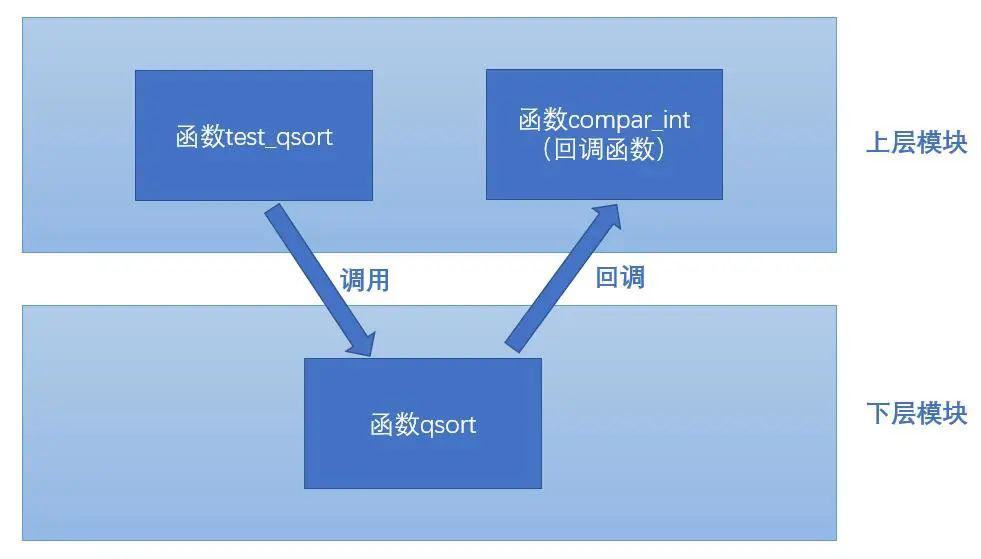жң¬ж¬Ўз»ҷеӨ§е®¶еҲҶдә«еҮ дёӘеөҢе…ҘејҸCдёӯзҡ„е®һз”ЁжҠҖе·§гҖӮ
1гҖҒеҠЁжҖҒз»‘е®ҡгҖҒеӣһи°ғеҮҪж•°
еӣһи°ғеҮҪж•°еҸҜд»ҘиҫҫеҲ°еҠЁжҖҒз»‘е®ҡзҡ„дҪңз”ЁпјҢеңЁдёҖе®ҡзЁӢеәҰдёҠеҸҜд»ҘйҷҚдҪҺеұӮдёҺеұӮд№Ӣй—ҙзҡ„иҖҰеҗҲгҖӮе…ідәҺеӣһи°ғеҮҪж•°пјҢд№ӢеүҚе·Із»ҸжңүеҶҷиҝҮдёҖзҜҮпјҡгҖӮеҸҜиғҪеҫҲеӨҡеҲқеӯҰзҡ„е°ҸдјҷдјҙеҸҜиғҪиҝҳдёҚзҗҶи§Јеӣһи°ғеҮҪж•°пјҢеҸҜд»ҘеҖҹеҠ©дёӢеӣҫжқҘзҗҶи§Јпјҡ

дёҖиҲ¬еҮҪж•°и°ғз”Ёзҡ„йЎәеәҸйғҪжҳҜдёҠеұӮеҮҪж•°пјҲи°ғз”ЁиҖ…пјүи°ғз”ЁдёӢеұӮеҮҪж•°пјҲиў«и°ғз”ЁиҖ…пјүгҖӮиҖҢйҖҡиҝҮдёҠеӣҫжҲ‘们еҸҜд»ҘзңӢеҲ°дёӢеұӮжЁЎеқ—зҡ„еҮҪж•°2и°ғз”ЁдәҶдёҠеұӮжЁЎеқ—зҡ„еҮҪж•°3пјҢиҝҷдёӘи°ғз”ЁиҝҮзЁӢдёҺдёҖиҲ¬зҡ„и°ғз”ЁиҝҮзЁӢзӣёеҸҚпјҢиҝҷдёӘиҝҮзЁӢеҸ«еҒҡеӣһи°ғпјҢиҝҷйҮҢдёҠеұӮжЁЎеқ—зҡ„еҮҪж•°3е°ұжҳҜеӣһи°ғеҮҪж•°гҖӮеӣһи°ғеҮҪж•°зҡ„иЎЁзҺ°еҪўејҸжҳҜеҮҪж•°жҢҮй’ҲгҖӮ
Cеә“stdlib.hдёӯеёҰжңүдёҖдёӘжҺ’еәҸеҮҪж•°пјҡqsortеҮҪж•°гҖӮиҝҷдёӘжҺ’еәҸеҮҪж•°зҡ„еҺҹеһӢдёәпјҡ
void qsort(void *base, size_t nitems, size_t size, int (*compar)(const void *, const void*));
еҸӮж•°пјҡ
- base-- жҢҮеҗ‘иҰҒжҺ’еәҸзҡ„ж•°з»„зҡ„第дёҖдёӘе…ғзҙ зҡ„жҢҮй’ҲгҖӮ
- nitems-- з”ұ base жҢҮеҗ‘зҡ„ж•°з»„дёӯе…ғзҙ зҡ„дёӘж•°гҖӮ
- size-- ж•°з»„дёӯжҜҸдёӘе…ғзҙ зҡ„еӨ§е°ҸпјҢд»Ҙеӯ—иҠӮдёәеҚ•дҪҚгҖӮ
- compar-- з”ЁжқҘжҜ”иҫғдёӨдёӘе…ғзҙ зҡ„еҮҪж•°пјҢеҚіеҮҪж•°жҢҮй’ҲпјҲеӣһи°ғеҮҪж•°пјүгҖӮ
int compar(const void *p1, const void *p2);
еҰӮжһңcomparиҝ”еӣһеҖје°ҸдәҺ0пјҲ< 0пјүпјҢйӮЈд№Ҳp1жүҖжҢҮеҗ‘е…ғзҙ дјҡиў«жҺ’еңЁp2жүҖжҢҮеҗ‘е…ғзҙ зҡ„е·Ұйқўпјӣ
еҰӮжһңcomparиҝ”еӣһеҖјзӯүдәҺ0пјҲ= 0пјүпјҢйӮЈд№Ҳp1жүҖжҢҮеҗ‘е…ғзҙ дёҺp2жүҖжҢҮеҗ‘е…ғзҙ зҡ„йЎәеәҸдёҚзЎ®е®ҡпјӣ
еҰӮжһңcomparиҝ”еӣһеҖјеӨ§дәҺ0пјҲ> 0пјүпјҢйӮЈд№Ҳp1жүҖжҢҮеҗ‘е…ғзҙ дјҡиў«жҺ’еңЁp2жүҖжҢҮеҗ‘е…ғзҙ зҡ„еҸійқўгҖӮ
дҫӢеӯҗпјҡ

#include <stdio.h>
#include <stdlib.h>
int compar_int(const void *p1, const void *p2)
{
return (*((int*)p1) - *((int*)p2));
}
void test_qsort(void)
{
int arr[5] = {8, 5, 10, 1, 100};
printf("жҺ’еәҸеүҚпјҡ");
for (int i = 0; i < 5; i++)
{
printf("%d ", arr[i]);
}
qsort((int*)arr, 5, 4, compar_int);
printf("\nжҺ’еәҸеҗҺпјҡ");
for (int i = 0; i < 5; i++)
{
printf("%d ", arr[i]);
}
}
int main(void)
{
test_qsort();
return 0;
}
зј–иҜ‘гҖҒиҝҗиЎҢз»“жһңпјҡ

д»ҘдёҠе°ұжҳҜжң¬ж¬Ўзҡ„еҲҶдә«пјҢеҰӮжңүй”ҷиҜҜпјҢж¬ўиҝҺжҢҮеҮәпјҢи°ўи°ўгҖӮиҝҷжҳҜ第дёҖеј№пјҢеҗҺз»ӯиҝҳдјҡ继з»ӯеҲҶдә«жӣҙеӨҡе®һйҷ…ејҖеҸ‘дёӯе®һз”Ёзҡ„зј–зЁӢе°ҸжҠҖе·§еҸҠзј–зЁӢз»ҸйӘҢгҖӮж¬ўиҝҺжҢҒз»ӯе…іжіЁгҖӮжң¬ж–ҮеҸӘжҳҜзӣҳзӮ№дәҶдёҖдәӣе®һз”Ёе°ҸжҠҖе·§пјҢ并дёҚжҳҜиҜҙж— и®әд»Җд№ҲеңәжҷҜдёӢйғҪиҰҒиҝҷд№Ҳз”ЁпјҢиҝҳйңҖе…·дҪ“й—®йўҳе…·дҪ“еҲҶжһҗгҖӮ
2гҖҒдҪҝз”Ёе®Ҹз»ҷз»“жһ„дҪ“еҲқе§ӢеҢ–
еҰӮжһңйў‘з№ҒдҪҝз”ЁдёҖдёӘз»“жһ„дҪ“зҡ„иҜқпјҢдҪҝз”ЁдҪҝз”Ёе®ҸжқҘз»ҷз»“жһ„дҪ“иҝӣиЎҢиөӢеҖјжҳҜеҫҲж–№дҫҝзҡ„дёҖз§ҚеҒҡжі•гҖӮ
дҫӢеӯҗпјҡ
#include <stdio.h>
#define NEW_RECT(length, width) {(length), (width)}
typedef struct _Rect
{
int length;
int width;
}Rect;
int main(void)
{
Rect rect = NEW_RECT(10, 5);
printf("rect length = %d, width = %d\n", rect.length, rect.width);
return 0;
}
зј–иҜ‘гҖҒиҝҗиЎҢз»“жһңпјҡ

иҝҷз§Қж–№жі•еңЁRT-Threadзҡ„еә•еұӮgpioй©ұеҠЁдёӯд№ҹжңүи§ҒеҲ°пјҡ

3гҖҒз»“жһ„дҪ“еҶ…зҪ®еҮҪж•°жҢҮй’Ҳ
жҲ‘们常常жһ„йҖ дёҖдәӣз»“жһ„дҪ“жқҘеӯҳеӮЁж•°жҚ®пјҢ然еҗҺеңЁдёҖдәӣеҮҪж•°дёӯдҪҝз”Ёиҝҷдәӣз»“жһ„дҪ“гҖӮдёӢж¬ЎдёҚеҰЁжҠҠж•°жҚ®дёҺж“ҚдҪңж•°жҚ®зҡ„еҮҪж•°з»‘еңЁдёҖиө·пјҢжӣҙжё…жҷ°жҳҺдәҶгҖӮ
зӣёе…іж–Үз« пјҡ
дҫӢеӯҗпјҡ
#include <stdio.h>
#define NEW_RECT(length, width) {(calc_area), (length), (width)}
typedef struct _Rect
{
int (*calc_area)(struct _Rect *pThis);
int length;
int width;
}Rect;
int calc_area(struct _Rect *pThis)
{
return (pThis->length * pThis->width);
}
int main(void)
{
Rect rect = NEW_RECT(10, 5);
printf("rect length = %d, width = %d\n", rect.length, rect.width);
printf("rect area = %d\n", rect.calc_area(&rect));
return 0;
}
зј–иҜ‘гҖҒиҝҗиЎҢз»“жһңпјҡ

4гҖҒдҪҝз”Ёdo{}while(0)е°ҒиЈ…е®Ҹ
#define DBG_PRINTF(fmt, args...) \
do\
{\
printf("<<File:%s Line:%d Function:%s>> ", __FILE__, __LINE__, __FUNCTION__);\
printf(fmt, ##args);\
}while(0)
е…·дҪ“иҜҙжҳҺеҸҜжҹҘйҳ…еҫҖжңҹж–Үз« пјҡ
5гҖҒvoid*
д№ӢеүҚеңЁдёӯжңүд»Ӣз»ҚиҝҮvoid*гҖӮvoid*е…¶е®һжҲ‘们平时йғҪжңүжҺҘи§ҰиҝҮпјҢжҜ”еҰӮпјҡ
void *malloc(size_t size) ;
void *memcpy(void *destin, void *source, unsigned n);
......
void *еёёеёёз”ЁдәҺеҮҪж•°ең°е°ҒиЈ…жҜ”иҫғеӨҡпјҢеҪ“然д№ҹжңүз”ЁеңЁе…¶е®ғең°ж–№пјҢжҜ”еҰӮеңЁз»“жһ„дҪ“еҶ…е®ҡд№үvoid*зұ»еһӢзҡ„з§ҒжңүжҢҮй’Ҳж–№дҫҝжү©еұ•з»“жһ„дҪ“гҖӮжҲ‘们平时еңЁе°ҒиЈ…иҮӘе·ұзҡ„еҮҪж•°ж—¶пјҢд№ҹеҸҜд»ҘеӨҡиҖғиҷ‘зңӢзңӢжңүжІЎжңүеҝ…иҰҒдҪҝз”Ёvoid*дҪҝеҫ—еҮҪж•°ең°йҖҡз”ЁжҖ§жӣҙејәдёҖдәӣгҖӮ
еҰӮжһңжң¬ж–ҮеҜ№дҪ жңүеё®еҠ©пјҢдёҚеҰЁиҪ¬еҸ‘еҲҶдә«пјҢи°ўи°ў~
-End-
гҖҢжңүз”Ёе°ұжү©ж•ЈгҖҚ
зӮ№еҮ»дёӢж–№вҖң硬件攻еҹҺзӢ®вҖқе…іжіЁпјҢйҖүжӢ©вҖңзҪ®йЎ¶/жҳҹж Үе…¬дј—еҸ·вҖқ
з”өеӯҗжҠҖжңҜе№Іиҙ§пјҢ第дёҖж—¶й—ҙйҖҒиҫҫ
????


